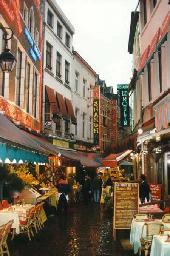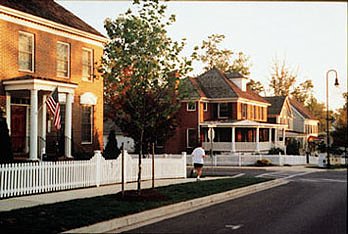
How to live in the 21st century
by Nick van der Leek
New Urbanism is the best option for sustainable living in the 21st century, irrespective of whether we choose to live according to its principles or not, and when we make that choice. And, as has been pointed out in several earlier articles, it’s likely that in time we won’t have a choice. Suburbia, such as it is – an energy intensive project – has no future.
A good example of a building that won’t work in the future is the simple skyscraper. Simply because they require far too much energy to run and too many people are accommodated on too small a parcel of land for local resources to meet their needs. Buildings that will work are some of the older buildings, especially the very old buildings that served a multiple role, often housing shops and offices in close proximity to each other and the ground.
New Urbanism is a movement that started in the 80’s, and was really a response to cold, disconnected, inefficient, and often ugly edifices that went up along the highways and byways, like fast food boxes and shiny steel and glass shopping warehouses. New Urbanism tries to recreate a more traditional way of living, bringing beauty and functionality back into urban living. Much of old Europe, with its 6 and 7 storey buildings, its compact cobbled streets filled with a multitude of stores walkable distances from residences, reflect this style.
New Urbanism then, offers a return to streets that are quieter, more pedestrianised and friendlier. This is an arrangement that has a population density greater than that of suburbia (its stand alone homes), but less than apetment blocks. It basically seeks to accommodate an adequate amount of people without overpowering local resources and farming capacities. In other words, New Urbanism attempts to connect people once again to organic systems in an area, for example streams and forests and nearby cultivated fields and small factories. It allows housing mixed with offices and other functional spaces that are also energy efficient, or even produce their own electricity. These will not include stand alone housing, or any large complex filled with single occupant spaces. Parking bays are replaced with sidewalks, parks, fountains or vegetable markets. Bicycles and in some areas, trams or streetcars, will make a comeback, along with local shoemakers.
The current setup is not only ugly, but quite sterile and dysfunctional. Especially in Johannesburg, there are miles of sprawl interspersed with factory showrooms and corporate palaces. From the comfort of an Audi, these may make sense, but on foot or on a bicycle, it’s a ludicrous waste of space. Why have offices an hours drive from home when you could walk to them in 5 or 10 or 20 minutes? Same with schools and shops. In South Africa, where we don’t have a subway system, big shopping centres that require people to get into their cars in large numbers will be replaced by much smaller shops specializing in produce, baking and other cottage industries. The corner café will return, but their offerings may be quite different from what we’ve been used to.
In Bloemfontein there are very few traditional, walkable urban spaces left, but, if we can carry some of our affluence into the future, the original city centre may be revived, and fountains in the square may be appreciated once more, and derelict buildings may well be resurrected as people flee faraway townhouses and homes on the city limits, in favor of locations closer (walking distance) from markets and functioning urban water and perhaps power supplies. More than likely, we won’t see prudent investment, but desperate people very quickly creating new urban slums. Flats close to the city, especially where there are many close together, will first fill up, and then empty. Bloemfontein’s Preller Square is a modern addition that seems – perchance perhaps – to come out of the New Urbanist’s manual, except for the massive parking lots surrounding it on all sides, and to some extent, limited accommodation in the central section.
It’s likely that as depletion sets in, there will be a large scale upheaval in suburbia everywhere. The author James Howard Kunstler calls it a meltdown, as people fall over themselves to get out of the cul de sacs, and closer to some kind of local infrastructure. It’s likely to be chaotic, possibly even violent. There may be long queues at service stations, and plenty of fistfights in supermarkets over loaves of bread and bottles of milk. Meanwhile, some people may organize themselves into groups, trying to address local scarcities as best they can. Having access to borehole water will help. Front gardens may turn into vegetable gardens, but it won’t be enough. Those who have already made preparations to power their homes (using solar for example) will handle the transition better, but of course, those who haven’t will soon find those better off than themselves.
The current era is likely to be filled with seriousness and appalling uncertainty. If we are able to invest our energies in projects like New Urbanism, we may be able to absorb the impact of imminent depletion better than most. If we simply function as we have done – simply reacting when conditions worsen, then we face an increasingly grim scenario. Remember, in a world where the gap between resources and demand is permanent, where the carrying capacity of the planet is completely out of whack, we face a long term decline, and after every crisis is another crisis, worse than its predecessor.
It remains a question whether people will continue with their psychology of previous investment, or whether they will awaken out of the consumer craze, not because they are forced to, but because they choose to.

No comments:
Post a Comment